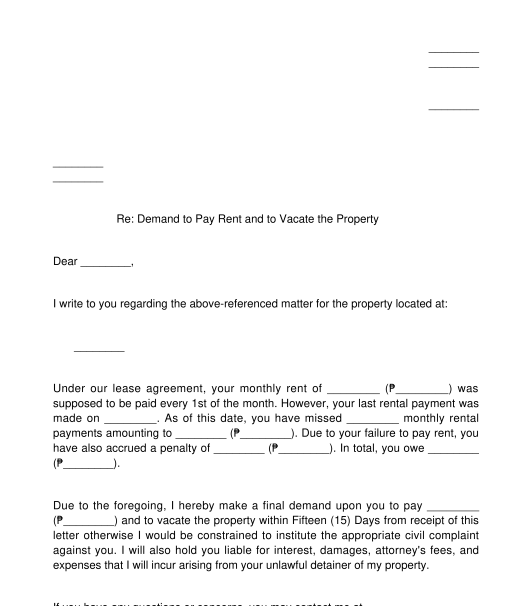 09/16/2025
09/16/2025

Answer a few questions and your document is created automatically.

Your document is ready! You will receive it in Word and PDF formats. You will be able to modify it.

 09/16/2025
09/16/2025
 Word and PDF
Word and PDF
 1 page
1 page
A Demand Letter for Ejectment should be used when the owner of a property wants to recover the possession of the property from a person who is currently possessing the same (the "possessor"). This should be used when the possessor unlawfully withholds possession of the property after his right to possession is terminated i.e. when a lease contract ends, or when the possessor forcibly entered or trespassed the property and stayed thereon.
Generally, it is not necessary to send a demand letter before beginning judicial proceedings to recover possession of the property. However, if the judicial proceedings will be for unlawful detainer, it is necessary for the landlord/owner to first send a demand letter to the tenant or the person occupying the property to pay the rent or comply with the conditions of the lease contract and to vacate the property. An exception to this exception is if the unlawful detainer is based on the expiration of the lease, in which case a demand letter is not necessary.
There is an unlawful detainer when the possessor unlawfully withholds possession of the property after his right to possession is terminated. The right of the possessor to possess the property can come from an express contract, such as a lease agreement, or an implied contract, such as when the owner allows the possessor to enter and stay on the property out of the generosity of the owner.
Examples of unlawful detainer are:
In the given examples, the person in possession of the property had a right to possess the property (because of the lease contract or the consent of the owner) and the said right ended (by the demand of the owner to vacate and surrender the property or the expiration of the lease).
A Demand Letter for Ejectment contains the following information:
In cases where the possessor is a tenant and is requested to leave the property, take note of the following prerequisites:
In cases where the possessor is not a tenant or has no existing agreement with the owner of the property such as lease, the possessor can be asked to leave the property without any qualification similar to the previous paragraphs.
The sender is the person who owns the property and wants to demand another to leave the same. And the recipient is asked to leave the property. The sender must affix his signature thereon to signify that he wants to eject or ask the possessor to leave the property.
If it will be sent via registered mail, at least two original copies should be printed. Both original copies of the letter should be signed by the sender (the person who is asking the other to leave the property), one original copy should be kept by the sender and the other should be sent to the recipient (the possessor) by registered mail. After sending, the registry receipt or mail receipt in relation to the mailing of the second original copy must be kept by the sender.
If it will be sent via email, the sender must send an email attaching one scanned copy of the letter that is duly signed by the sender or one digital copy that is electronically signed by the sender. An email is a recommended way of sending this letter as the letter is sent instantly and it will enable the parties to keep their records in a convenient manner.
The documents showing the sender's proof of ownership over the property should be attached if desired. Examples of these documents are a copy of the Transfer Certificate of Title of the property involved, and its tax declaration.
Costs for sending the Demand Letter may depend on the method used by the sender in sending the letter. Email and instant messaging are the most cost-efficient ways of sending a letter as they are generally free, whereas costs for registered mail or courier will be dependent on the distance between the residence of the sender and the recipient.
There are no laws outlining the requirements for a Demand Letter for Eviction except if the cause is unlawful detainer. If the cause is unlawful detainer, the Rules of Court provides that the demand must be to pay or comply with the conditions of the lease and to vacate the property. It also provides for the proper mode of service (or delivery) of the demand letter. The Rent Control Act is applicable in cases where the property is located in the National Capital Region or highly urbanized cities and the total monthly rent ranges from One Peso (P1.00) to Ten Thousand Pesos (P10,000.00), or if the property is located in other areas and the monthly rent ranges from One Peso (P1.00) to Five Thousand Pesos (P5,000.00).
You fill out a form. The document is created before your eyes as you respond to the questions.
At the end, you receive it in Word and PDF formats. You can modify it and reuse it.
Guides to help you
Demand Letter for Ejectment - sample template
Country: Philippines